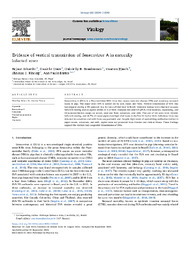Evidence of vertical transmission of Senecavirus A in naturally infected sows.
Evidence of vertical transmission of Senecavirus A in naturally infected sows.
Author(s): SCHAEFER, R.; GAVA, D.; BOMBASSARO, G. E.; HAACH, V.; MACIAG, S. S.; BASTOS, A. P. A.
Summary: Abstract: Senecavirus A (SVA) is a Picornaviridae RNA virus that causes vesicular disease (VD) and transitory neonatal losses in pigs. The major ways SVA is spread are by oral, nasal, and feces. Vertical transmission of SVA was investigated during a VD epidemic in a farrow-to-finish herd in Brazil. Vesicular lesions were observed on sows before farrowing and on piglets within 24 h of birth. Analyses included RT-qPCR, viral isolation, sequencing, and virus-neutralization assays on serum, vesicular fluid, colostrum, and milk. Five out of ten sows were viremic before farrowing, and 46.7% of tested piglets had high viral loads in the first 24 h after birth. Infectious virus was detected in colostrum and milk from one postnatal sow. Despite high levels of neutralizing antibodies (nAbs) in piglet serum, colostrum, and milk, piglets were not protected from viremia and clinical illness. These findings support the vertical and congenital transmission of SVA.
Publication year: 2024
Types of publication: Journal article
Unit: Embrapa Swine & Poultry
Keywords: Colostro, Colostrum, Leitão, Piglets, Senecavirus A, Transmissão de Doença, Vertical transmission, Virolactia, Virologia
Observation
Some of Embrapa's publications are published as ePub files. To read them, use or download one of the following free software options to your computer or mobile device. Android: Google Play Books; IOS: iBooks; Windows and Linux: Calibre.
Access other publications
Access the Agricultural Research Database (BDPA) to consult Embrapa's full library collection and records.
Visit Embrapa Bookstore to purchase books and other publications sold by Embrapa.

